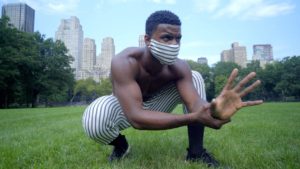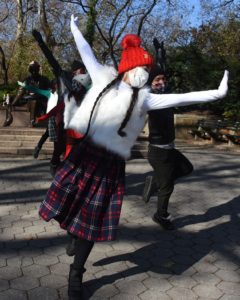
While producers concede that Broadway won’t likely open until next fall, the next best thing—thanks to New York’s new “Open Culture” legislation—will be here this spring, debuting on a street corner near you.
New “Open Culture” laws passed by the City Council on Dec. 10 will allow for live ticketed performances on streets, plazas, and in city parks, following in the footsteps of the city’s Open Streets and Open Restaurants initiatives, which cordon off sections of roadway for socially distanced pedestrian traffic and restaurant seating.
“There’ll be music, dance, theater, and comedy on the streets in all five boroughs, for all people to see,” says City Council member Jimmy Van Bramer (D-Queens), who sponsored the legislation. Another bill sponsored by Council majority leader Laurie Cumbo (D-Brooklyn) establishes a new streamlined online permit process.
Local entertainers are relieved.
“It is about time,” says Alejandra Duque Cifuentes, executive director of Dance/NYC, a nonprofit serving more than 5,000 dancers in and around New York. “We expect there to be a wave of performances in the spring.”
The prospect of outdoor gigs comes with concerns—weather, noise, bugs, to name a few—yet many industry leaders sound optimistic, seeing Open Culture as a way to not only fill a void but find new audiences and build brands.
“Going outside doesn’t just give artists a chance to perform,” says Vineyard Theatre artistic director Sarah Stern. “It’s a way to reach new people and activate the city with the power and energy of theater.”
New York’s performing arts industry—including theater, music, and dance—employs more than 17,000 individuals, according to the comptroller’s 2019 Creative Economy report. Van Bramer hopes the new laws will renew the spirits of these workers. And their bank accounts.
“For the first time ever groups can charge for these performances,” he says. “That’s a big change.”
The city has traditionally issued permits for cultural performances in publicly owned spaces when they are free. They are essentially gifts to the city by artists, Van Bramer explains.
Very complicated gifts, that is.
Stern learned this last fall when she tried to produce a series of 10-minute vaudeville-style solo shows by the irreverent Broadway actor and performance artist Bill Irwin. Staging the series in a plaza east of the Flatiron building, Stern had to work in concert with the Department of Transportation and the Flatiron/23rd Street Business Improvement District to wade through the application process, spread over several agencies. The restrictions were onerous.
“We could have our members come and see it but we could not advertise or sell tickets,” she says. “We could’ve done a lot more with it otherwise.”
The Vineyard is currently planning new outdoor programming for spring, including an extended series with Irwin, and other longer-form works, this time for a nominal fee.
“Artists need to be paid for their art and time,” Van Bramer says. “You can’t just go to a park with a bottle of wine and enjoy a performance—and not pay anything.”
So what can you expect to see this spring?
Not “ Hamilton, ” “Company,” or “Moulin Rouge”—not likely, or at least not fully staged versions of those productions.
“Part of Broadway is the orchestra, the set, the costumes, and all of that doesn’t really happen outdoors,” says Charlotte St. Martin, president of the Broadway League, the national trade organization for Broadway theater owners and operators. The closest thing to an outdoor Broadway show is the Public Theater’s Shakespeare in the Park, performed at the Delacorte Theater in Central Park. “And even they have a building,” she notes. “The audience sits outside but the actors sit inside, where they store costumes and props.”
Smaller-scale productions and one-man or one-woman shows will no doubt prove a better fit outdoors, along with concerts, stand-up comedy, and dance.
Choreographer Alison Cook-Beatty and her dance company took to the great outdoors this past summer. Sick of Zoom rehearsals, she’s created seven new works during the Covid lockdown, and the group has rehearsed and performed them—with masks and social distancing—in Manhattan’s Central Park and Carl Schurz Park.
“We used what was around us: baseball fields, forests, benches, monuments, even the snow contributed to the work,” she says.
Getting to interact with the community was an unexpected publicity boost. “People would walk by and take pictures and videos,” she recalls. “They’d talk to us. Dogs would run in and out of our space.”

Photo by Russell Haydn
At the Flatiron, Irwin didn’t have dogs at his feet, but passing subway trains. Initially thrown by the deafening noise, he incorporated it into the act, pausing and giving a deferential nod as the trains rumbled by.
“There’s something wonderful about doing work outside and having the life of the streets seep into it,” Stern says. “There’s real energy to that. It’s alive.”
Performers will need to be prepared for such challenges, particularly sound and sightline issues. Also bugs, notes Broadway veteran and Tony Award nominee Liz Callaway, who has performed outdoors at various venues, from the White House to Virginia’s Wolf Trap stage to the Mets’ Citi Field singing the National Anthem.
She takes bugs seriously, having been stung by a bee as a teenager—inside her throat. “I swallowed it!” she says, laughing. Less dangerous but equally annoying are the swarms of gnats and mosquitoes. “Anytime I perform and there are bugs, I’m like ohmygodohmygod. You don’t want to open your mouth as wide, and that’s a challenge.”
Then there’s the weather.
“Weather’s effects on valuable instruments, including tuning, cannot be overstated,” notes Robin Zeh, an accomplished violinist who plays with the American Ballet Theatre Orchestra, the Orchestra of St. Luke’s , and various Broadway pit orchestras. Extreme heat and humidity can cause wooden instruments to swell. The effects on singing-and-dancing humans can be troublesome, too.
Despite these perils, nature’s unexpected collaborations can be joyous. “I remember hearing birds respond at a classical concert when I was performing at Caramoor,” says Zeh, recalling the outdoor venue in Katonah, N.Y. Such moments are serendipitous, and can make the event more memorable than it might’ve been in a standard music hall.
A Proper Warm-Up
Outdoor venues won’t replace the thrill of being packed into a theater or club, but they may provide a necessary warm-up to the real thing.
“One of the big question marks is not just when will it be safe to return to theaters, but when will people feel comfortable doing so,” says Signature Theatre artistic director Paige Evans.
Rather than heading outside, Evans hopes to coax people inside their lobby first, perhaps by late spring. The Frank Gehry-designed Signature Center boasts four theaters and an airy lobby, café, and bookstore that’s as large as a museum gallery.
“Trying to bring people back into the building in advance of shows seems like a good intermediary step,” she says. She’s currently in talks with Pulitzer Prize-winning playwright Lynn Nottage to develop a sound and video installation that can be viewed by socially distanced attendees. Nottage teaches a class at Columbia University on making theater in non-traditional spaces, and recently created an immersive, multi-media installation in a defunct train station in Reading, Penn.
If such an installation isn’t possible, Evans will consider performances on the sidewalk out front.
The options are limitless, Van Bramer says.
“I think it will lift everyone’s spirits, while putting artists back to work and allowing them to be paid,” he says. “This is a jobs creator, an economic engine, an emotional relief, and sort of the rediscovery of joy that we as human beings need.”
Source: https://www.barrons.com/articles/like-restaurants-new-york-theater-is-going-al-fresco-this-spring-01609271284

